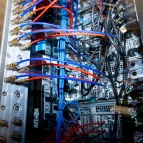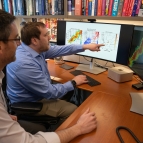Arctic Climate Change Detection Network

The effects of global climate change are amplified in the Arctic, where the significant loss of sea ice is among the most observable signals of change in the climate system. We are developing a low-cost, scalable sensor network for the Arctic that will collect environmental measurements and detect ice fracturing events linked to Arctic climate change.
In 2024, we deployed six prototype sensor systems on an ice flow in the Arctic Ocean 200 nautical miles north of Prudhoe Bay, Alaska, as part of Operation Ice Camp run by the U.S. Navy’s Arctic Submarine Laboratory. The rugged, easy-to-deploy sensor nodes monitor conditions above, at, and below the sea ice simultaneously, and at a high sample rate. Above the ice, sensors capture wind and temperature measurements; in the ice, seismometers capture vibrations caused by ice cracking and fracturing; and below the ice, hydrophones (underwater microphones) and echosounders measure important qualities of the water column.

Our team’s journey began in 2022 with our first trip to the Arctic as participants in ICEX (now called Operation Ice Camp). Since then, we have collaborated with Michigan Tech's Great Lakes Research Center, University of New Hampshire, and the International Arctic Buoy Program to further test and develop our sensors.
We intend to use the sensor data to build algorithms that can automatically detect ice events such as fractures, as well as to detect changes in the environment that may contribute to these fractures. Our goal is to build a better understanding of ice dynamics in the rapidly changing Arctic climate system to feed further research in the North polar region.




